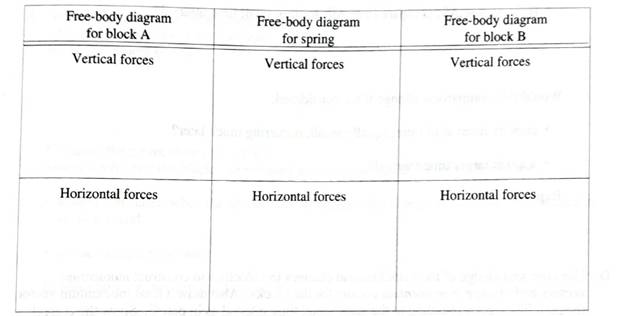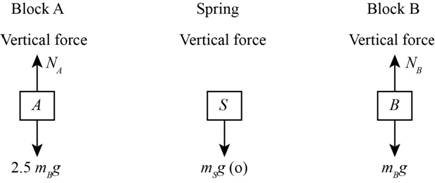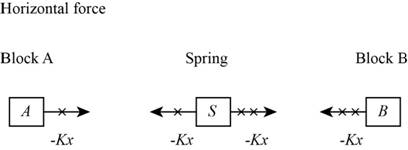
Concept explainers
Draw separate free-body diagrams for each block and for the spring immediately after release. Indicate separately the vertical forces (perpendicular to the table top) and the horinra1 forces (parallel to the table top). Clearly label all forces.

Identify all the  each member of the second pair as
each member of the second pair as etc.).
etc.).
The free body diagram of block and spring.
Explanation of Solution
Introduction:
Newtonian mechanics states that force never occurs singly in nature. Force is the mutual interaction between two bodies. The mutual forces are always equal and opposite in direction.
When the block is being apart, the spring force is acting towards the equilibrium position, and the block is coming towards each other as the spring is compressed.
In the vertical direction, force is acting on the block due to gravity.
The free body diagram in the vertical direction is shown in figure 1.

Figure 1
The free body diagram in horizontal direction is shown in figure 2.

Figure 2
Conclusion:
Therefore, the free body diagram in the vertical and horizontal direction is shown in Figures 1 and 2 respectively.
Want to see more full solutions like this?
Chapter 3 Solutions
Tutorials In Introductory Physics: Homework
Additional Science Textbook Solutions
Genetic Analysis: An Integrated Approach (3rd Edition)
Organic Chemistry (8th Edition)
Cosmic Perspective Fundamentals
Campbell Biology (11th Edition)
Microbiology with Diseases by Body System (5th Edition)
Chemistry: The Central Science (14th Edition)
- pls help on thesearrow_forward20. Two small conducting spheres are placed on top of insulating pads. The 3.7 × 10-10 C sphere is fixed whie the 3.0 × 107 C sphere, initially at rest, is free to move. The mass of each sphere is 0.09 kg. If the spheres are initially 0.10 m apart, how fast will the sphere be moving when they are 1.5 m apart?arrow_forwardpls help on allarrow_forward
- 19. Mount Everest, Earth's highest mountain above sea level, has a peak of 8849 m above sea level. Assume that sea level defines the height of Earth's surface. (re = 6.38 × 106 m, ME = 5.98 × 1024 kg, G = 6.67 × 10 -11 Nm²/kg²) a. Calculate the strength of Earth's gravitational field at a point at the peak of Mount Everest. b. What is the ratio of the strength of Earth's gravitational field at a point 644416m below the surface of the Earth to a point at the top of Mount Everest? C. A tourist watching the sunrise on top of Mount Everest observes a satellite orbiting Earth at an altitude 3580 km above his position. Determine the speed of the satellite.arrow_forwardpls help on allarrow_forwardpls help on allarrow_forward
- 6. As the distance between two charges decreases, the magnitude of the electric potential energy of the two-charge system: a) Always increases b) Always decreases c) Increases if the charges have the same sign, decreases if they have the opposite signs d) Increases if the charges have the opposite sign, decreases if they have the same sign 7. To analyze the motion of an elastic collision between two charged particles we use conservation of & a) Energy, Velocity b) Momentum, Force c) Mass, Momentum d) Energy, Momentum e) Kinetic Energy, Potential Energyarrow_forwardpls help on all asked questions kindlyarrow_forwardpls help on all asked questions kindlyarrow_forward
 Glencoe Physics: Principles and Problems, Student...PhysicsISBN:9780078807213Author:Paul W. ZitzewitzPublisher:Glencoe/McGraw-Hill
Glencoe Physics: Principles and Problems, Student...PhysicsISBN:9780078807213Author:Paul W. ZitzewitzPublisher:Glencoe/McGraw-Hill University Physics Volume 1PhysicsISBN:9781938168277Author:William Moebs, Samuel J. Ling, Jeff SannyPublisher:OpenStax - Rice University
University Physics Volume 1PhysicsISBN:9781938168277Author:William Moebs, Samuel J. Ling, Jeff SannyPublisher:OpenStax - Rice University Physics for Scientists and Engineers: Foundations...PhysicsISBN:9781133939146Author:Katz, Debora M.Publisher:Cengage Learning
Physics for Scientists and Engineers: Foundations...PhysicsISBN:9781133939146Author:Katz, Debora M.Publisher:Cengage Learning
 College PhysicsPhysicsISBN:9781285737027Author:Raymond A. Serway, Chris VuillePublisher:Cengage Learning
College PhysicsPhysicsISBN:9781285737027Author:Raymond A. Serway, Chris VuillePublisher:Cengage Learning Physics for Scientists and Engineers, Technology ...PhysicsISBN:9781305116399Author:Raymond A. Serway, John W. JewettPublisher:Cengage Learning
Physics for Scientists and Engineers, Technology ...PhysicsISBN:9781305116399Author:Raymond A. Serway, John W. JewettPublisher:Cengage Learning





